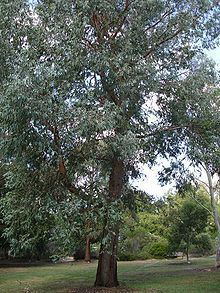Genus Eucalyptus Rank Species | ||
 | ||
Similar Eucalyptus caliginosa, Eucalyptus angophoroides, Eucalyptus olsenii, Eucalyptus cretata, Eucalyptus capitellata | ||
Eucalyptus chapmaniana, commonly known as the Bogong gum, is a small to medium-sized tree of montane and subalpine eastern Victoria and far south-eastern New South Wales.
Contents
Description
Eucalyptus chapmaniana grows as a tree to 35 m (100 ft) tall. It forms a woody base known as a lignotuber. The bark on trunk is partly or completely rough, fibrous and finely fissured longitudinally grey or brown-grey, branches smooth, light brown to creamy-white or pale grey, with long ribbons of decorticated bark in the branches, branchlets sometimes glaucous.
Similar species
E. chapmaniana is distinguished from other common 3-budded species in the mountain forests, viz. E. globulus subsp. bicostata, E. dalrympleana, E. rubida and E. viminalis, by the rough bark over most of the trunk, smooth branches shedding bark in very long ribbons, and bluish green crown. It has the opposite, orbicular to ovate seedling leaves of E. rubida and E. dalympleana which further distinguish it from E. viminalis which is more likely to occur in valleys than on well-drained slopes preferred by E. chapmaniana. It differs from E. glaucescens in having more an obconical fruit with a conspicuous raised disc and exserted valves.
Taxonomy
Eucalyptus chapmaniana was named in 1947 after Brigadier Dr. Wilfrid Chapman (1891–1955), after he had drawn attention to its existence.
Wilfrid (the son of Frederick Chapman, the eminent paleontologist) had a long and distinguished career as a civil engineer and was a Fellow of the Institute of Engineers. He also had a keen interest in botany and was particularly interested in Eucalyptus species. He was an associate of the Royal Society of Victoria, was awarded an Honorary Doctorate by the University of Western Australia, and was also Commissioner and later the Chairman of the SECV. He was first to discover the tree which now bears his name on his numerous visits to the Kiewa power station which is situated near the Bogong high plains. A sample of the Bogong Snow Gum tree is planted in the Maranoa Gardens in Balwyn, Victoria and is identified by a plaque. His father Frederick was instrumental in setting up the Maranoa Gardens and is honoured at the entrance marked as the Chapman Gate.
Eucalyptus chapmaniana belongs in Eucalyptus subgenus Symphyomyrtus section Maidenaria, a large group of species more or less restricted to south-eastern Australia, characterized by bilobed cotyledons, simple axillary inflorescences, buds with two opercula, stamens with versatile anthers and flattened seeds with a ventral hilum. Within this section, E. chapmaniana, with 9 other species, forms series Orbiculares having orbicular to ovate juvenile leaves opposite for many nodes, a blue-green crown, buds in 3s. Series Orbiculares is confined to far south-eastern New South Wales, eastern Victoria and Tasmania.
